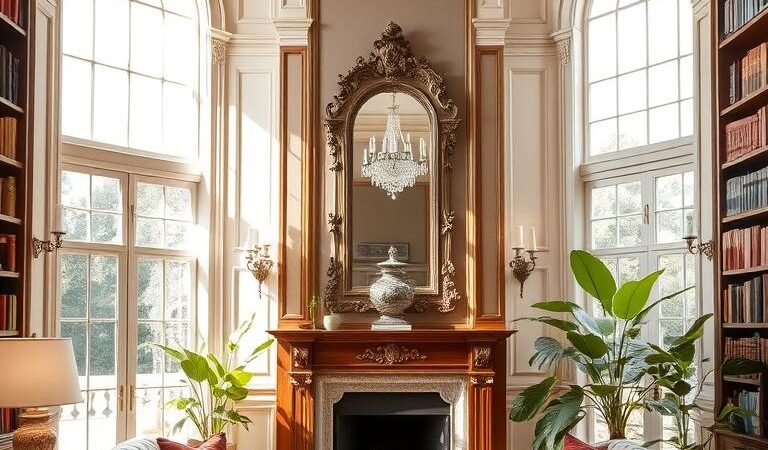Some spaces never go out of style. A well-designed area blends history with modern comfort, creating a welcoming atmosphere. Think of soft fabrics, balanced layouts, and carefully chosen furniture—each piece tells a story.
Years ago, formal spaces were symbols of status. Today, they balance sophistication with relaxation. Symmetry, rich textures, and warm lighting bring harmony. These details turn a simple space into a place that feels both refined and inviting.
Experts like Decorilla merge tradition with today’s needs. The result? A look that stays fresh while honoring timeless roots. Whether through plush seating or soft color palettes, every choice adds to the room’s charm.
Key Takeaways
- Classic design balances elegance with everyday comfort.
- Symmetry and quality furniture create a polished look.
- Textures and lighting enhance warmth and depth.
- Modern touches keep traditional spaces feeling current.
- Thoughtful details make the space both beautiful and functional.
1. The Essence of Timeless Classic Living Room Decor
Great design feels familiar yet fresh, blending heritage with modern ease. It’s not about replicating the past but weaving its best elements into today’s comforts. Think of arched doorways paired with sleek lighting or heirloom rugs anchoring minimalist furniture.
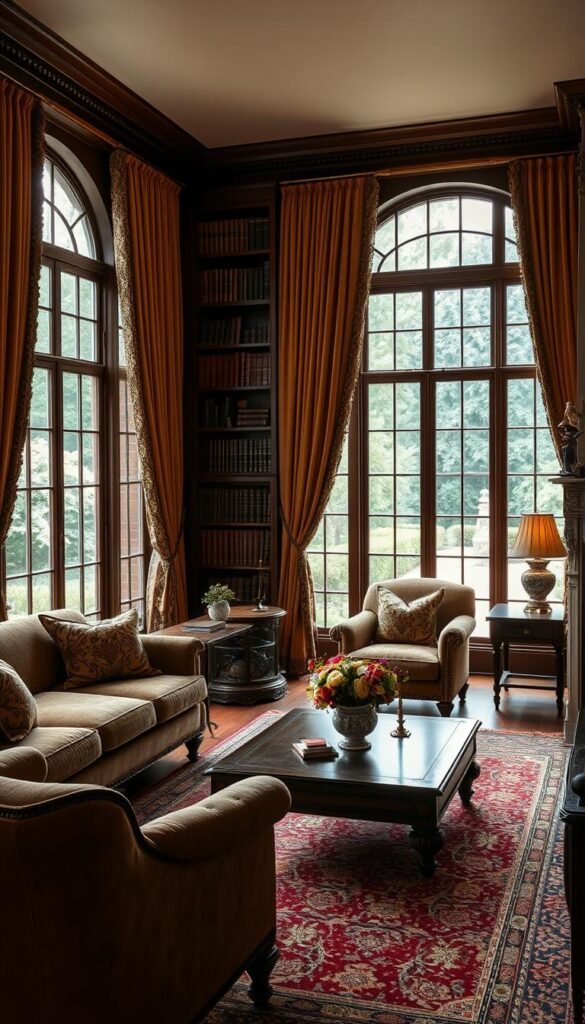
Why Timeless Design Never Fades
Eighteenth-century symmetry still guides layouts today. Balanced arrangements—like twin armchairs flanking a fireplace—create harmony. Designers like Decorilla reinforce this by pairing antique mirrors with modular sofas. The result? Historical continuity meets contemporary flexibility.
Chesterfield sofas exemplify endurance. Once horsehair-stuffed, they now feature performance fabrics for durability. Kira David Design updates Victorian moldings with crisp lines, proving tradition thrives when adapted. Even black-and-white photography, as Becca Interiors shows, bridges eras with monochrome elegance.
Balancing Tradition and Modernity
A refined living room avoids feeling like a museum. Mix eras intentionally: a gilded console beside abstract art, or velvet drapes with metal floor lamps. The key is cohesion—shared colors or textures tie disparate pieces together.
Lighting plays a pivotal role. Crystal chandeliers gain edge with matte-black finishes. Meanwhile, open shelving displays both porcelain vases and stacked coffee-table books. This style respects history while celebrating now.
Pro Tip:
- Layer textures—linen pillows on leather chairs—for depth.
- Use muted tones as a base, then add jewel-toned accents.
- Anchor the space with one statement antique (e.g., a clock or trunk).
2. The History of Formal Living Rooms: A Foundation for Elegance
The roots of elegant interiors trace back to 18th-century Europe, where artistry met opulence. These spaces showcased wealth through intricate moldings, oil paintings, and hand-carved furniture. Today, they inspire designs that balance grandeur with livability.
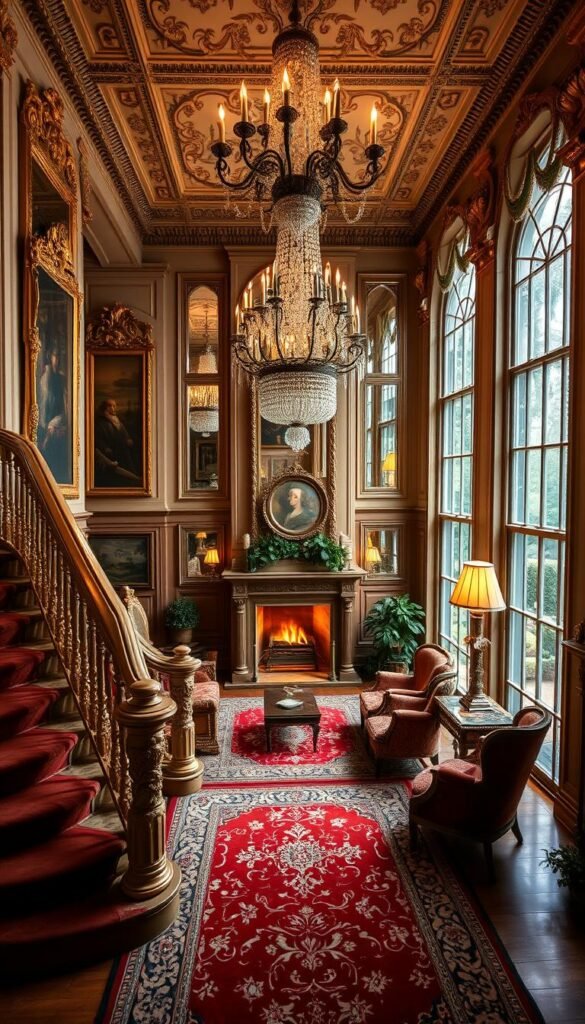
18th-Century Origins
Formal rooms began as status symbols. Think marble fireplaces and silk-upholstered chairs—each detail announced prestige. Designers like Jane Beiles honor this legacy by preserving original wood paneling in renovations. The craftsmanship still feels fresh.
Victorian-era drapes, once heavy and ornate, now get lightweight updates. Croma Design swaps brocade for linen, keeping drama without the bulk. It’s a nod to history with modern ease.
Evolution into Modern Spaces
Smart tech seamlessly blends into traditional layouts. Amanda Teal hides speakers in fireplace surrounds, while Allison Elebash integrates USB ports into Art Deco tables. Function meets heritage.
Sotheby Realty listings prove old-world charm endures. Crown moldings now glow under LED accents, merging history with today’s lighting trends. The result? Rooms that feel both storied and current.
Key Adaptations:
- Materials: Linen replaces velvet for breezy sophistication.
- Tech: Hidden wiring preserves clean lines.
- Lighting: LEDs highlight architectural details.
3. Timeless Color Schemes for a Sophisticated Look
Colors shape the mood of a space, setting the tone for elegance and warmth. Whether soft neutrals or bold accents, the right palette creates harmony. Designers like Bria Hammel and Holly Antoine masterfully blend hues to craft rooms that feel both fresh and enduring.
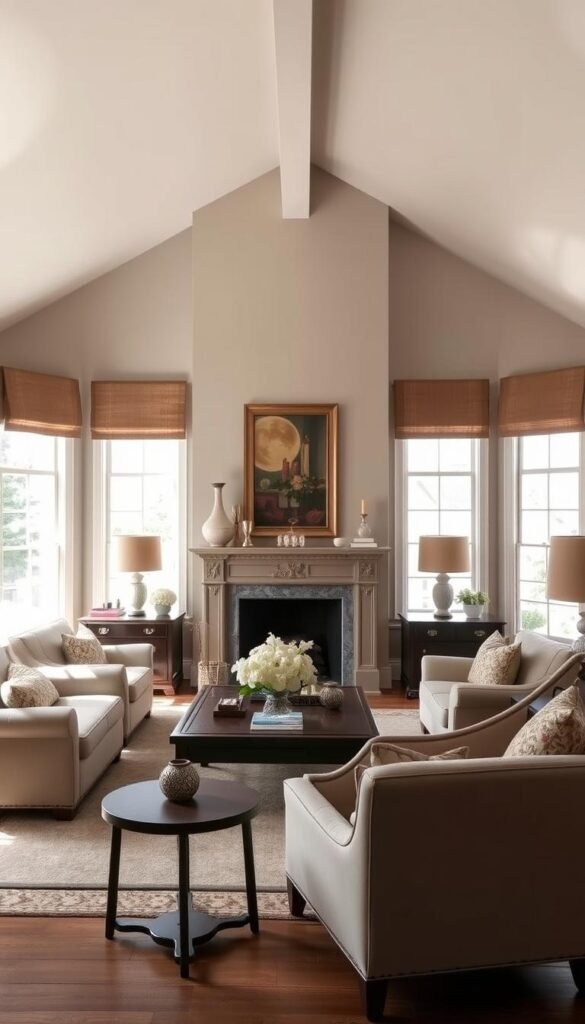
Neutral Palettes: A Safe Bet
Neutrals form the backbone of refined interiors. Farrow & Ball’s *School House White* anchors rooms with crisp warmth, while *Mouse’s Back* adds subtle depth. These shades let textures—like linen or aged wood—shine. For a modern twist, layer in metallic finishes or matte black accents.
Jewel Tones for Drama
Deep emerald or sapphire transforms spaces into luxurious retreats. Kelli E. pairs emerald velvet drapes with brass sconces, creating a striking contrast. Decorilla’s navy walls with gilded frames prove dark colors needn’t feel heavy—just intentional.
Muted Pastels for Soft Elegance
Blush pinks and sage greens bring quiet sophistication. Holly Antoine layers Benjamin Moore’s *Pale Oak* with silky blush throws, balancing cool and warm tones. The result? A room that feels airy yet grounded.
Pro Tips:
- Use a 60-30-10 rule: 60% neutral, 30% secondary, 10% accent.
- Test colors in natural light—shifts in tone affect the whole space.
- Repeat a hue in small doses (pillows, art) for cohesion.
4. Furniture Selection: Classic Pieces That Stand the Test of Time
Furniture defines a room’s character—choosing enduring pieces ensures lasting appeal. From Chesterfield sofas to wingback chairs, these designs marry form and function. The secret? Quality craftsmanship and intentional mixing.
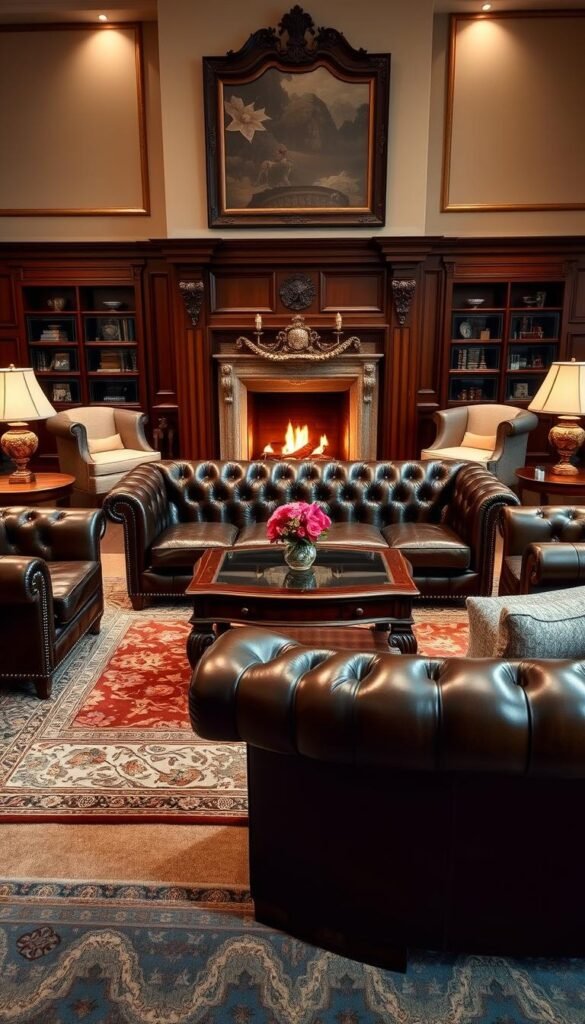
The Chesterfield Sofa: A Timeless Staple
Originally crafted for 18th-century aristocrats, Chesterfield sofas remain icons. Restoration Hardware’s modern versions feature deep tufting and performance velvet—ideal for daily use. Pair one with a sleek coffee table for contrast.
Why it works:
- Durability: Lee Industries uses stain-resistant fabrics on traditional silhouettes.
- Versatility: Equally at home in libraries or loft apartments.
Wingback Chairs for Refinement
Amelia R. updates Bernhardt’s wingbacks with hairpin legs, blending old-world charm with mid-century flair. The high back offers comfort, while the open base keeps spaces airy.
Designers love them for:
- Creating intimate seating nooks.
- Adding height to low-ceilinged rooms.
Mixing Eras for Eclectic Charm
Decorilla pairs Eames lounge chairs with Chippendale tables—proof that eras can harmonize. The trick? Shared materials or colors. Try a brass lamp on a walnut sideboard to tie styles together.
Pro Tip: Interior Define’s customizable sectionals mimic traditional roll arms. Choose a bold fabric for a modern punch.
5. Symmetry and Balance: The Heart of Traditional Design
Symmetry isn’t just about matching pairs; it’s about creating visual harmony. A well-proportioned layout makes a room feel intentional—neither stiff nor chaotic. Designers achieve this by blending structured arrangements with subtle surprises.
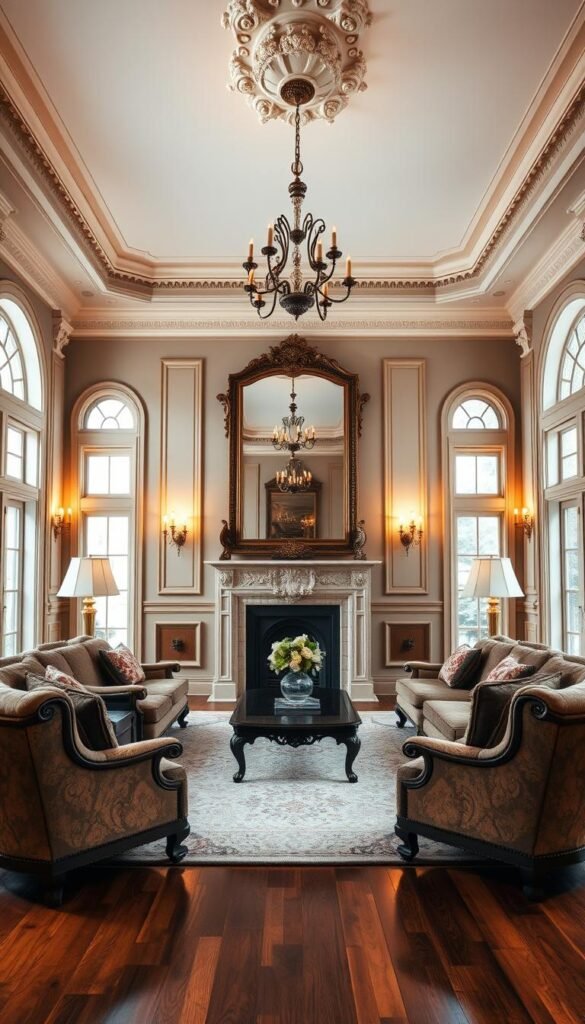
Arranging Furniture for Harmony
Collins Interiors swears by the 72″ rule: keep facing sofas at this distance for easy conversation. Twin bergères flanking a bold, asymmetric art piece—like Decorilla’s approach—add modernity to tradition. The contrast keeps the balance dynamic.
HollyGrace.ca layers symmetry with variation. Matching lamps anchor a room, while mismatched side tables introduce personality. It’s a trick that preserves order without monotony.
Avoiding Overcrowding
Anthropologie’s sculptural consoles prove focal points need breathing room. Christopher Norman’s manual emphasizes traffic flow: leave 36″ pathways for movement. Overfilled spaces lose their elegance.
Pro Tips:
- Use rugs to define zones without physical barriers.
- Pair heavy furniture with leggy pieces (e.g., a chunky sofa with a glass coffee table).
- For more formal living room ideas, balance scale in open-concept areas.
6. Luxurious Fabrics to Elevate Your Space
Luxury begins with the right fabrics, blending comfort with sophistication effortlessly. Whether draped over furniture or layered as accents, textiles set the tone for a room’s ambiance. The key lies in balancing opulence with practicality—materials that feel as good as they look.
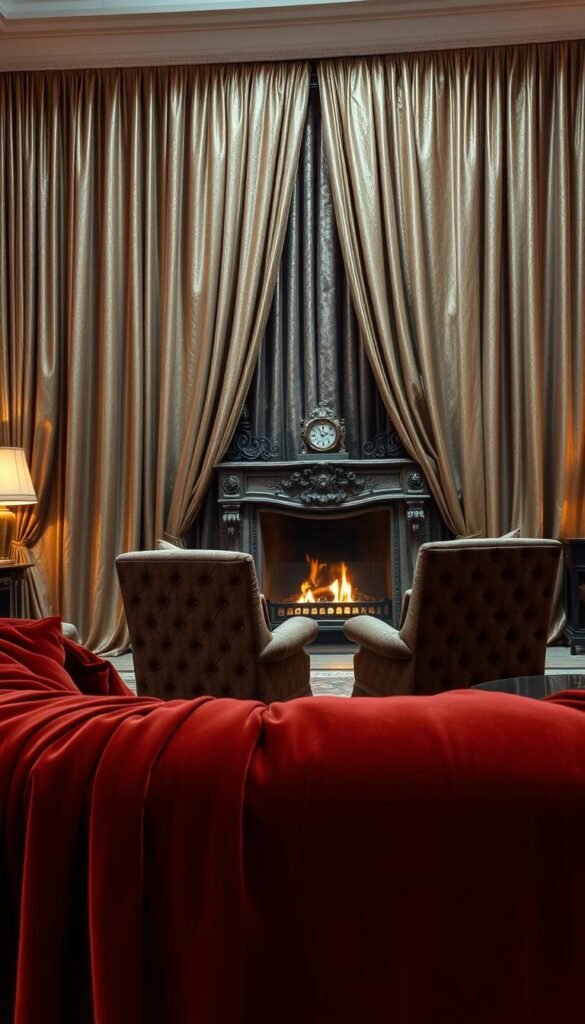
Velvet: Opulence and Comfort
Velvet’s soft touch elevates any piece, from sofas to throw pillows. Schumacher’s performance velvet outshines traditional silk dupioni, offering stain resistance without sacrificing richness. Perfect for high-traffic areas, it brings depth to neutral palettes or bold jewel tones.
Designers love its versatility:
- Pair emerald velvet armchairs with a linen sofa for contrast.
- Use matte-finish velvet on ottomans to avoid glare.
Silk and Linen for Lightness
For airy elegance, Kravet’s indoor-outdoor linen drapes sunrooms in effortless style. Thread Count Lab’s silk alternatives—like washable tencel—mimic silk’s sheen while standing up to daily wear. Holly Hunt’s wool blends add warmth, ideal for textured throws or area rugs.
Pro Tip: Decorilla’s layering technique—velvet pillows on linen sofas—creates tactile contrast. Mix heavyweight and lightweight fabrics to balance visual interest with comfort.
7. Lighting That Enhances Elegance
Lighting transforms a space from ordinary to extraordinary with just the right glow. The right fixtures do more than illuminate—they sculpt shadows, highlight textures, and set moods. Decorilla designers emphasize three layers: ambient, task, and accent lighting for dimensional warmth.
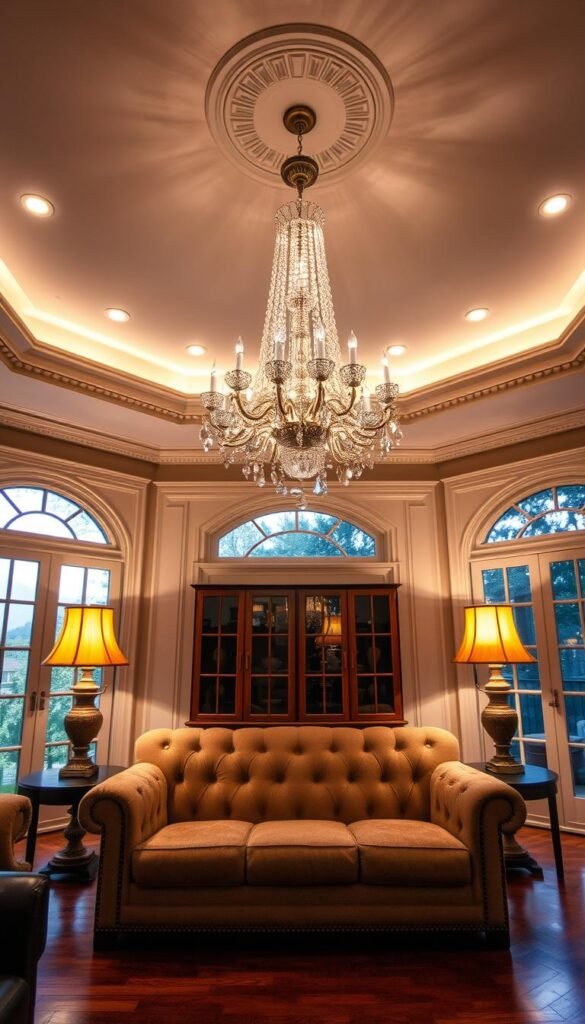
Chandeliers as Focal Points
Nothing commands attention like a sculptural chandelier. Visual Comfort’s crystal designs refract light into rainbows, while Tech Lighting’s LED versions offer energy efficiency. Position one over a coffee table or foyer to anchor the space.
Pro tip: Scale matters. A 30″ wide chandelier suits most 12’x12′ rooms. For vaulted ceilings, add 3″ per foot of height.
Layered Lighting for Warmth
Combine sources for adaptable ambiance:
- 3000K overhead lights for general illumination
- 2700K table lamps by seating areas
- Dimmable sconces (like Hudson Valley’s WiFi-enabled designs) for adjustable mood
Alison Elebash’s formula ensures balance: 100 watts per 50 square feet. This creates enough light without glare.
Modern Lamps with Classic Touches
Circa Lighting’s brass swing-arm lamps bridge eras beautifully. Their adjustable arms work over vintage consoles or bedside tables. The warm brass finish nods to tradition, while clean lines keep things current.
For reading nooks, consider:
- Ceramic bases with organic shapes
- Fabric shades that diffuse light softly
- Matte black finishes for contrast against light walls
Remember—lighting should feel intentional, not accidental. Each fixture contributes to the room’s story.
8. Artwork and Decor: Curating a Refined Aesthetic
Art transforms walls into stories, turning blank spaces into curated galleries. The right decor pieces whisper elegance, adding layers of personality to any room. Whether through bold paintings or delicate antiques, each choice reflects a thoughtful touch.
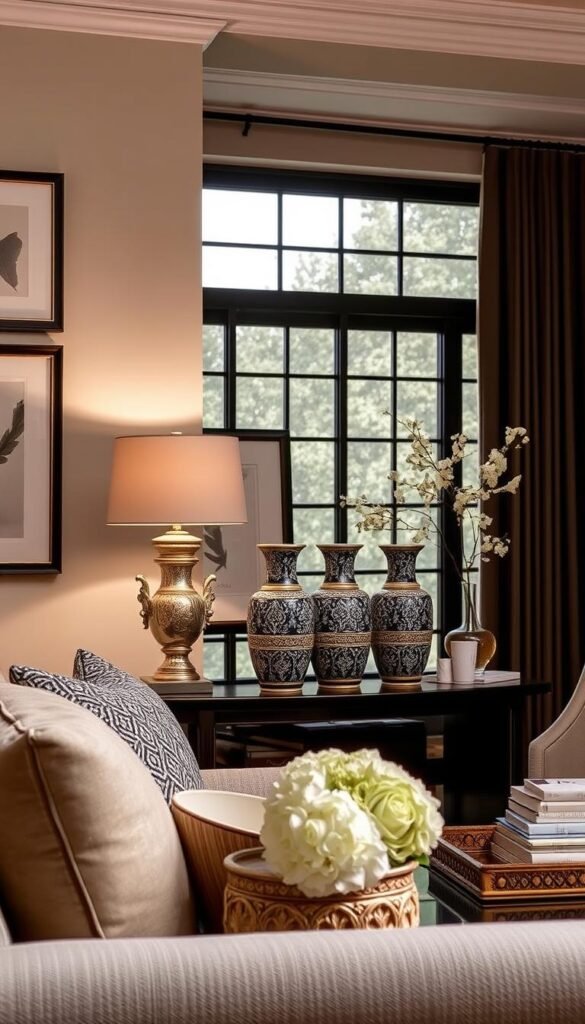
Classic Paintings and Mirrors
Large, ornate-framed artworks command attention while maintaining traditional appeal. Serena & Lily’s archival prints, like their botanical collections, bring heritage charm. Framebridge’s custom gilded frames elevate family photos into heirloom-worthy displays.
Mirrors amplify light and space. A well-placed Venetian mirror creates a striking focal point, especially in smaller rooms. Pair one with a console table for a vignette that balances function and artistry.
Black-and-White Photography
Monochrome images add timeless contrast. A gallery wall of architectural shots or candid portraits introduces graphic boldness. For cohesion, stick to uniform matting—white or black—to let the art shine.
Sculptures and Antiques
Arteriors’ contemporary busts, carved from classical marble, blend old-world craftsmanship with modern lines. Source ethically through Chairish’s verified program, which authenticates pieces like 19th-century bronze figurines.
Pro Tip: Use the art sizing formula—2/3 of the wall’s width x 0.75 height—for perfect proportions. A 48″ wide piece suits a 72″ wall beautifully.
- Layer textures: A lacquered sculpture atop a weathered wood table.
- Mix scales: Petite objets d’art beside oversized canvases.
- Rotate seasonal pieces to keep the space dynamic.
9. The Role of Rugs in Defining Spaces
Floor coverings do more than protect floors—they shape the entire feel of a space. The right choice ties furniture together, muffles sound, and adds tactile warmth. Whether traditional or contemporary, rugs create visual boundaries that make rooms feel intentional.
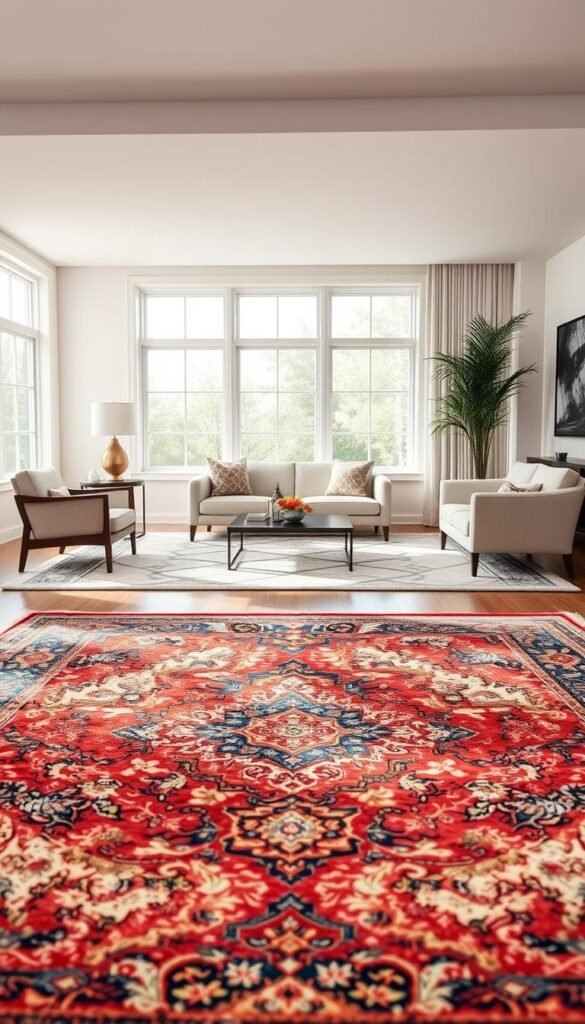
Persian Rugs for Tradition
Safavieh’s hand-knotted wool pieces showcase centuries-old craftsmanship. Their vegetable-dyed hues—like madder root reds—age beautifully, becoming family heirlooms. Stark’s custom dye process replicates this patina, giving new rugs antique charm without the fragility.
For high-traffic areas, consider:
- 8×10 sizing: Leaves 18-24″ of exposed floor around seating groups
- Low-pile options: Easier to vacuum than deep shags
- Fringe-free edges: Prevent tripping in busy households
Modern Rugs with Classic Patterns
Ruggable’s washable designs merge heritage motifs with spill-proof technology. Their medallion patterns reference Persian traditions but use stain-resistant poly blends. Loloi’s Joanna Gaines collection offers transitional stripes and florals that bridge eras seamlessly.
| Type | Best For | Care Tip |
|---|---|---|
| Wool Persian | Formal seating areas | Professional cleaning every 2 years |
| Performance Poly | Kitchen-adjacent spaces | Machine wash cold |
| Stain-Resistant Wool | Pet-friendly homes | Blot spills immediately |
Cape Cod Carpets proves luxury and practicality coexist. Their treated wool fibers repel pet accidents while maintaining softness underfoot. Layer one over jute for texture contrast in a complete look that balances durability and style.
10. Window Treatments: Drapes vs. Modern Shades
Window treatments shape both light and mood, acting as the finishing touch to any refined space. They control sunlight, add texture, and frame views—all while reinforcing a room’s style. Designers often layer multiple types for flexibility, like pairing blackout linings with breezy sheers.
Heavy Drapes for Grandeur
Robert Allen’s velvet drapes cascade with weighty elegance, ideal for formal spaces. Their interlined construction blocks drafts and noise, while pinch-pleat headings create uniform folds. For media rooms, Smith & Noble adds blackout linings that eliminate glare without sacrificing richness.
Proper installation ensures flawless function:
- Rods should extend 6″ beyond window frames for full stacking
- Lead-free linen tape headings (like Restoration Hardware’s) prevent sagging
- Floor-length panels add height; hover 1/2″ above for clean lines
Lightweight Curtains for Airiness
The Shade Store’s motorized linen shades bring modern lightness to traditional homes. Graber’s solar shades with embroidered borders offer UV protection while maintaining visibility—perfect for sunrooms. Layered with sheer voile, they diffuse light beautifully.
Design tips for ethereal effects:
- Use double rods to combine sheers and opaque drapes
- Choose ripple-fold headers for smooth operation
- Match metal finishes to room hardware for cohesion
11. Creating a Focal Point: Fireplaces and Mantels
A fireplace instantly becomes the heart of a room—radiating warmth and history in equal measure. Whether gas, wood-burning, or electric, its design sets the tone for the entire space. From rustic stone surrounds to sleek modern inserts, this focal point invites both admiration and cozy gatherings.
Classic Fireplace Designs
Rumford fireplaces, with their tall, shallow fireboxes, reflect 18th-century efficiency. Today’s direct-vent inserts mimic their elegance while offering better heat output. Fireclay Tile’s hand-glazed surrounds replicate historic hues—think Hearthstone Red or Slate Gray—for authenticity without the upkeep.
For a seamless blend of old and new:
- Material contrast: Pair a limestone surround with a matte-black insert.
- Vent-free options: Ethanol burners suit homes without chimneys.
- Safety first: Maintain 12″ clearance between decor and firebox.
Styling the Mantel
The rule of thirds creates visual harmony: anchor with a large mirror or artwork, then layer smaller objects at varying heights. Circa Lighting’s hand-carved corbels add antique flair to floating shelves. For balance, mix textures—a brass candlestick beside a stacked book collection.
| Element | Styling Tip | Brand Example |
|---|---|---|
| Anchor Piece | Oversized landscape painting | Serena & Lily |
| Height Variation | Tapered candleholders + low bowl | Pottery Barn |
| Seasonal Swap | Swap botanicals for winter garlands | Terrain |
Pro Tip: Use LED pillar candles for flickering ambiance without fire risk. They’re especially handy in homes with curious pets or kids.
12. Incorporating Wood and Metal Accents
Wood and metal accents bring depth and contrast to any refined space. These materials balance organic warmth with sleek sophistication, creating a layered aesthetic. Whether through intricate carvings or gleaming fixtures, they add character without overwhelming the design.
Carved Wood Details
Historical Concepts’ reproduction moldings showcase hand-carved oak with botanical motifs, perfect for traditional homes. For modern alternatives, Metrie’s MDF options mimic walnut grain at a fraction of the cost. Both add subtle details to ceilings, doors, or fireplace surrounds.
Hudson Furniture’s resin-infused burl wood consoles merge artistry with durability. The swirling grain patterns catch light beautifully, making them ideal statement pieces. Pair one with a minimalist sofa to let the wood’s natural texture shine.
Ornate Metal Fixtures
Rejuvenation’s unlacquered brass switch plates develop a whisper of patina over time, adding lived-in charm. For bold contrast, Schlage’s matte black door hardware with crystal knobs blends vintage and contemporary vibes.
Pro Tip: Limit finishes to three per room for cohesion. Try:
- Brass lighting + iron cabinet pulls + nickel picture frames
- Blackened steel shelves + copper planters + chrome lamp bases
13. Modernizing Traditional Spaces
Bold contrasts can breathe new life into heritage-rich interiors. The key lies in strategic updates—think vibrant hues or striking artwork—that honor history while feeling current. Designers like Amber Interiors prove even Georgian homes can embrace today’s trends without losing their charm.
Bold Accent Colors
Farrow & Ball’s Hague Blue transforms built-in bookcases into dramatic focal points. For subtler impact, Thibaut’s geometric grasscloth wallpapers add texture without overwhelming. The 60-30-10 rule keeps bold choices balanced: 60% neutral walls, 30% secondary tones (like olive-green velvet sofas), and 10% for pops (think mustard-yellow pillows).
Pro Tip: Test swatches at different times of day. North-facing rooms need warm undertones to counter gray light.
Contemporary Art in Classic Rooms
Minted’s large-scale abstracts create striking contrasts above traditional tufted sofas. Arteriors’ LED-lit acrylic sculptures—placed beside wingback chairs—blend futuristic glow with old-world silhouettes. For cohesion, repeat one color from the artwork elsewhere (e.g., a cobalt vase matching a painting’s accent).
| Element | Modern Twist | Brand Example |
|---|---|---|
| Wall Color | Deep teal on wainscoting | Benjamin Moore |
| Artwork | Oversized black-and-white photo | Artfully Walls |
| Lighting | Sputnik chandelier | Visual Comfort |
Mix eras intentionally: A gilded mirror reflects a neon sign, or a Persian rug grounds a modular sectional. The result? A space that feels curated, not conflicted.
14. Seating Arrangements for Comfort and Style
Seating isn’t just about places to sit—it shapes how people connect in a space. The right mix of armchairs and sofas creates intimate conversation nooks while maintaining visual flow. Designers like Decorilla prove that even modular pieces can honor traditional silhouettes when thoughtfully arranged.
Overstuffed Armchairs
Lee Industries’ deep-seated club chairs exemplify comfort with their high-density foam cores. Compared to Joybird’s modular sectionals, these classic pieces offer structured support with rolled arms that nod to heritage designs. The secret lies in proportions—seat heights between 18″-20″ work best for most adults.
Four Hands’ swivel chairs add dynamic flexibility to traditional layouts. Their 360-degree rotation encourages face-to-face interaction without rearranging furniture. For families, Crypton’s stain-resistant fabrics on Lawson-style armchairs combine elegance with practicality.
Modular Sofas for Flexibility
Bernhardt’s sleeper sofas prove traditional seating can adapt to modern needs. The nailhead trim maintains classic appeal, while the queen-sized pull-out bed accommodates overnight guests. Arrange modular pieces in L-shapes or opposing pairs to define zones in open-concept spaces.
Optimal conversation distances:
- 8-10 feet between facing seats for easy discussion
- 30-inch walkways between furniture groupings
- 18-inch clearance between coffee tables and sofa fronts
For cohesive styling, match the scale of sofas to room dimensions. A 96″ sectional suits spaces over 14′ wide, while apartment-friendly 72″ loveseats maintain proportion in cozier areas. Layer with down-filled pillows and wool throws for tactile warmth.
15. Small Touches That Make a Big Impact
Luxury lives in the smallest accents—the glint of metal, the drape of fabric. These finishing accessories add personality and polish, turning curated spaces into welcoming homes. From throw pillows to metallic finishes, each detail contributes to a layered aesthetic.
Decorative Pillows and Throws
Samuel & Sons’ bullion fringe transforms basic linen pillows into heirloom-worthy accessories. Pair them with Peacock Alley’s Mongolian fur throws for tactile contrast—soft against structured furniture. The combination creates instant warmth while maintaining elegance.
Follow the “rule of three” when styling:
- Vary sizes (20×20″, 18×18″, lumbar)
- Mix patterns (floral, stripe, solid)
- Layer textures (velvet, silk, wool)
Metallic Finishes for Glamour
Regina Andrew’s mixed-metal table lamps prove finishes can coexist beautifully. Brushed nickel bases with brass accents catch light differently throughout the day. Waterford’s crystal decanters serve dual purposes—functional storage and reflective sparkle.
For balanced style:
- Anchor with one large metallic piece (mirror, chandelier)
- Add medium accents (bookends, picture frames)
- Finish with small details (drawer pulls, candle holders)
These nuanced choices create spaces that feel intentionally layered rather than overly decorated. The result? A home that whispers sophistication rather than shouting trends.
16. Conclusion: Crafting Your Timeless Living Room
Every detail matters when crafting a sophisticated retreat. Focus on quality pieces—like a hand-knotted rug or heirloom mirror—to build a foundation. Balance contrasts: pair sleek lamps with carved wood tables for depth.
Personal touches make the space yours. Blend family treasures with new finds. Decorilla’s free consultations help tailor plans to your taste.
Start small. Swap outdated lighting or add a layered rug. True elegance grows over time, adapting like fine wine. Your living room should tell your story—one intentional choice at a time.
